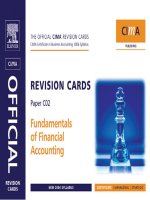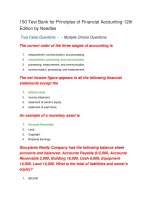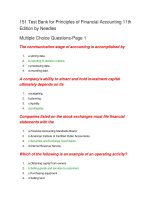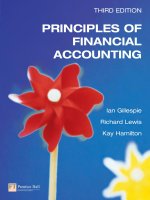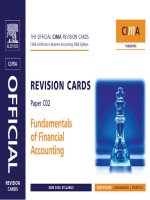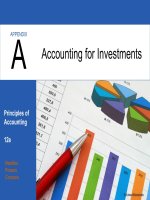Principles of financial accounting 12e by needles crosson chapter 16
Bạn đang xem bản rút gọn của tài liệu. Xem và tải ngay bản đầy đủ của tài liệu tại đây (361.91 KB, 26 trang )
C HAP TE R
16
Financial Statement Analysis
Principles of
Accounting
12e
Needles
Powers
Crosson
©human/iStockphoto
Concepts Underlying Financial
Performance Measurement
Financial statement analysis (or financial
performance measurement) is used to show how
items in a company’s financial statements relate to
the company’s financial performance objectives.
When analyzing financial statements, decision
makers must judge whether the relationships they
find in the statements are favorable or unfavorable.
– Many financial analysts, investors, and lenders apply
general standards, or rule-of-thumb measures, to key
financial ratios.
Current ratio: The higher the ratio, the more likely the
company will be able to meet its liabilities. A ratio of 2 to 1
(2.0) or higher is desirable.
Current liabilities to net worth ratio (%): Normally a business
starts to have trouble when this relationship exceeds 80%.
©2014 Cengage Learning. All Rights Reserved. May not be scanned, copied or duplicated, or posted to a publicly accessible website, in whole or in part.
Past Performance and Industry Norms
Comparing financial measures of the same company
over time is an improvement over using rule-of-thumb
measures.
– Such a comparison gives the analyst some basis for judging
whether the measure or ratio is getting better or worse.
However, using a company’s past performance is not helpful
in judging its performance relative to that of other companies.
Industry norms show how a company compares with
other companies in the same industry, which
overcomes some of the limitations of comparing a
company’s measures over time.
– However, diversified companies (or conglomerates)—
large companies that have multiple segments and operate
in more than one industry—may not be comparable to any
other company.
©2014 Cengage Learning. All Rights Reserved. May not be scanned, copied or duplicated, or posted to a publicly accessible website, in whole or in part.
Sources of Information
The major sources of information about public
corporations include:
– Reports published by a corporation
Annual reports
Interim financial statements—condensed financial
statements published each quarter and sometimes each
month
– Reports filed with the Securities and Exchange Commission
(SEC)
Annual reports (Form 10-K)
Quarterly reports (Form 10-Q)
Current reports (Form 8-K)
– Business periodicals and credit and investment advisory
services
The Wall Street Journal
Moody’s, Standard & Poor’s, and Dun and Bradstreet
©2014 Cengage Learning. All Rights Reserved. May not be scanned, copied or duplicated, or posted to a publicly accessible website, in whole or in part.
Horizontal Analysis
To gain insight into year-to-year
changes, analysts use horizontal
analysis, in which changes from the
previous year to the current year are
computed in both dollar amounts and
percentages.
– The percentage change is computed as follows:
Percentage Change = 100 × Comparative Year Amount − Base
Year Amount
Base Year Amount
- The base year is the first year considered in any set of
data.
©2014 Cengage Learning. All Rights Reserved. May not be scanned, copied or duplicated, or posted to a publicly accessible website, in whole or in part.
Trend Analysis
Trend analysis is a variation of
horizontal analysis that calculates
percentage changes for several
successive years instead of for just
two years.
– It uses an index number to show changes
in related items over time.
For an index number, the base year is set at 100
percent. Other years are measured in relation to
that number.
©2014 Cengage Learning. All Rights Reserved. May not be scanned, copied or duplicated, or posted to a publicly accessible website, in whole or in part.
Vertical Analysis
Vertical analysis shows how the different
components of a financial statement relate to a
total figure in the statement.
– The analyst sets the total figure at 100 percent and
computes each component’s percentage of that total.
– The resulting financial statement, which is expressed
entirely in percentages, is called a common-size
statement.
Vertical analysis and common-size statements are useful in
comparing the importance of specific components in the
operation of a business and in identifying important changes
in the components from one year to the next. They are often
used to make comparisons between companies.
©2014 Cengage Learning. All Rights Reserved. May not be scanned, copied or duplicated, or posted to a publicly accessible website, in whole or in part.
Financial Ratio Analysis
Financial ratio analysis identifies key relationships
between the components of the financial
statements.
– Investors and creditors use profit margin to evaluate a company’s
ability to earn a satisfactory income (profitability). They use asset
turnover to determine whether the company uses assets in a way
that maximizes revenue (total asset management). Their
combined effect is overall earning power—that is, return on assets.
– Liquidity is a company’s ability to pay bills when they are due and
to meet unexpected needs for cash. To evaluate a company’s
liquidity, analysts compute: cash flow yield; cash flows to sales;
cash flows to assets; and free cash flow.
– Financial risk refers to a company’s ability to survive in good times
and bad. Ratios related to financial risk include debt to equity,
return on equity, and interest coverage.
©2014 Cengage Learning. All Rights Reserved. May not be scanned, copied or duplicated, or posted to a publicly accessible website, in whole or in part.
Profit Margin and Asset Turnover
Profit margin measures the
net income produced by each
dollar of sales.
Asset turnover measures
how efficiently assets are used
to produce sales.
©2014 Cengage Learning. All Rights Reserved. May not be scanned, copied or duplicated, or posted to a publicly accessible website, in whole or in part.
Return on Assets and Cash Flow Yield
Return on assets measures a
company’s overall earning power,
or profitability.
Cash flow yield measures the
ability to generate operating cash
flows in relation to net income.
©2014 Cengage Learning. All Rights Reserved. May not be scanned, copied or duplicated, or posted to a publicly accessible website, in whole or in part.
Cash Flows to Sales and Cash Flows to Assets
Cash flows to sales refers to the
ability of sales to generate
operating cash flows.
Cash flows to assets measures the
ability of assets to generate
operating cash flows.
©2014 Cengage Learning. All Rights Reserved. May not be scanned, copied or duplicated, or posted to a publicly accessible website, in whole or in part.
Free Cash Flow
Free cash flow is a measure of the
cash remaining after providing for
commitments.
©2014 Cengage Learning. All Rights Reserved. May not be scanned, copied or duplicated, or posted to a publicly accessible website, in whole or in part.
Debt to Equity Ratio and Return on Equity
The debt to equity ratio shows the
amount of assets provided by
creditors in relation to the amount
provided by stockholders.
Return on equity measures the
return to stockholders.
©2014 Cengage Learning. All Rights Reserved. May not be scanned, copied or duplicated, or posted to a publicly accessible website, in whole or in part.
Interest Coverage
The interest coverage ratio is a
supplementary ratio that measures
the degree of protection creditors
have from default on interest
payments.
©2014 Cengage Learning. All Rights Reserved. May not be scanned, copied or duplicated, or posted to a publicly accessible website, in whole or in part.
Evaluating Operating Asset Management
and Market Strength with Ratios
The operating cycle spans the time it takes to
purchase inventory, sell it, and collect for it. The
financing cycle—the period between the time a
supplier must be paid and the end of the operating
cycle—defines how much financing the company
must have to support its operations.
– Because debt increases a company’s risk, it is important to keep
the financing period at a manageable level. Ratios that measure
operating asset management include inventory turnover, days’
inventory on hand, receivables turnover, days’ sales uncollected,
payables turnover, days’ payable, and current and quick ratio.
Market price is the price at which stock is bought
and sold.
- It must be related to earnings by considering the price/earnings
(P/E) ratio and the dividend yield.
©2014 Cengage Learning. All Rights Reserved. May not be scanned, copied or duplicated, or posted to a publicly accessible website, in whole or in part.
Inventory Turnover and
Days’ Inventory on Hand
Inventory turnover measures the
relative size of inventories.
Day’s inventory on hand measures
the average number of days that it
takes to sell inventory.
©2014 Cengage Learning. All Rights Reserved. May not be scanned, copied or duplicated, or posted to a publicly accessible website, in whole or in part.
Receivables Turnover and
Days’ Sales Uncollected
Receivables turnover measures the
relative size of accounts receivable
and the effectiveness of credit
policies.
Days’ sales uncollected measures
the average number of days it
takes to collect receivables.
©2014 Cengage Learning. All Rights Reserved. May not be scanned, copied or duplicated, or posted to a publicly accessible website, in whole or in part.
Payables Turnover and Days’ Payable
Payables turnover measures the
relative size of accounts payable
and the credit terms extended to a
company.
Days’ payable measures the
average number of days it takes to
pay accounts payable.
©2014 Cengage Learning. All Rights Reserved. May not be scanned, copied or duplicated, or posted to a publicly accessible website, in whole or in part.
Financing Period
The financing period is computed
by deducting the days’ payable
from the operating cycle (days’
inventory on hand + days’ sales
uncollected).
©2014 Cengage Learning. All Rights Reserved. May not be scanned, copied or duplicated, or posted to a publicly accessible website, in whole or in part.
Current Ratio and Quick Ratio
The current ratio measures shortterm debt-paying ability by
comparing current assets with
current liabilities.
The quick ratio differs from the
current ratio in that the numerator
of the quick ratio excludes
inventories and prepaid expenses.
©2014 Cengage Learning. All Rights Reserved. May not be scanned, copied or duplicated, or posted to a publicly accessible website, in whole or in part.
Price/Earnings (P/E) and Dividend Yield
Price/earnings (P/E) is the ratio of
the market price per share to
earnings per share.
Dividend yield measures a stock’s
current return to an investor in the
form of dividends.
©2014 Cengage Learning. All Rights Reserved. May not be scanned, copied or duplicated, or posted to a publicly accessible website, in whole or in part.
Evaluating Quality of Earnings
The quality of earnings refers to the substance of
earnings and their sustainability into future periods.
– It is affected by accounting method, accounting estimates, and
one-time items.
– Different accounting methods have different effects on net
income.
– The latitude that companies have in their choice of accounting
method could cause problems in the interpretation of financial
statements were it not for the conventions of full disclosure
and consistency.
Full disclosure requires management to explain, in a note
to the financial statements, the significant accounting
policies used.
Consistency requires that the same accounting procedures
be used from year to year.
©2014 Cengage Learning. All Rights Reserved. May not be scanned, copied or duplicated, or posted to a publicly accessible website, in whole or in part.
Accounting Estimates and One-Time Items
In allocating expenses among the periods that benefit
from them, accountants must make estimates and
exercise judgment, which will affect net income.
– Areas that require accounting estimates include: useful life of
assets; residual value of assets; uncollectible accounts
receivable; sales returns; total units of production; total
recoverable units of natural resources; amortization periods;
warranty claims; and environmental cleanup costs.
If earnings increase because of one-time items, that
portion of earnings will not be sustained in the future.
– Examples of one-time items include: gains and losses; writedowns and restructurings; and nonoperating items.
©2014 Cengage Learning. All Rights Reserved. May not be scanned, copied or duplicated, or posted to a publicly accessible website, in whole or in part.
Gains and Losses and Write-Downs
and Restructurings
When a company sells or disposes of operating assets or
marketable securities, a gain or loss generally results.
– These gains or losses appear in the operating section of the
income statement, but they usually represent one-time
events. From an analyst’s standpoint, they should be ignored
when considering operating income.
A write-down (or write-of) is a reduction in the
value of an asset below its carrying value on the
balance sheet.
A restructuring is the estimated cost of a change in
a company’s operations.
– Both write-downs and restructurings reduce current
operating income and boost future income by shifting future
costs to the current period.
©2014 Cengage Learning. All Rights Reserved. May not be scanned, copied or duplicated, or posted to a publicly accessible website, in whole or in part.
Nonoperating Items
The nonoperating items that appear on the
income statement include discontinued
operations—segments that are no longer part
of a company’s operations—and gains or losses
on the sale or disposal of these segments.
These items can significantly affect net income.
To make it easier to evaluate a company’s
ongoing operations, GAAP requires that gains
and losses from discontinued operations be
reported separately on the income statement.
©2014 Cengage Learning. All Rights Reserved. May not be scanned, copied or duplicated, or posted to a publicly accessible website, in whole or in part.
